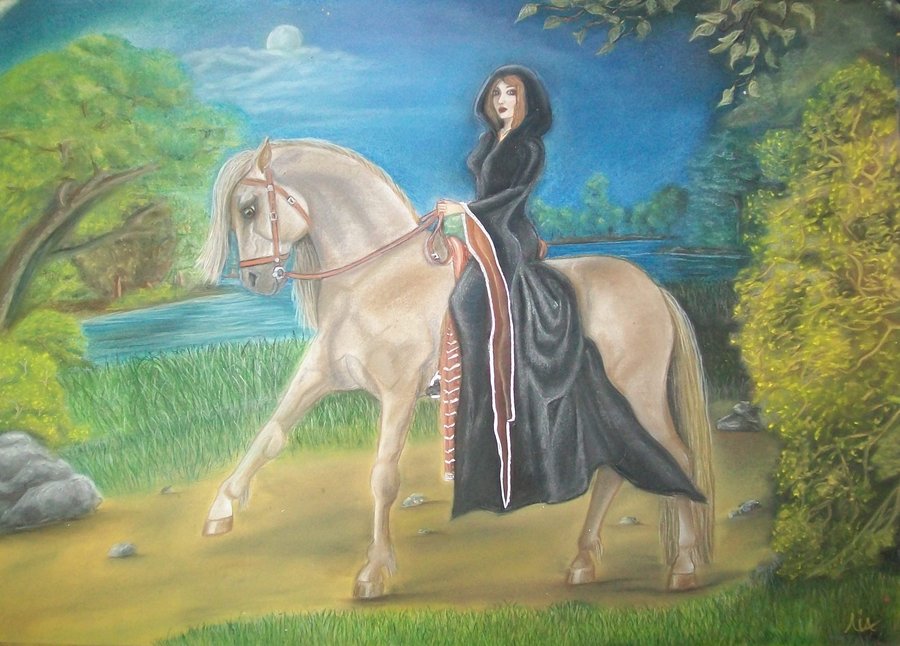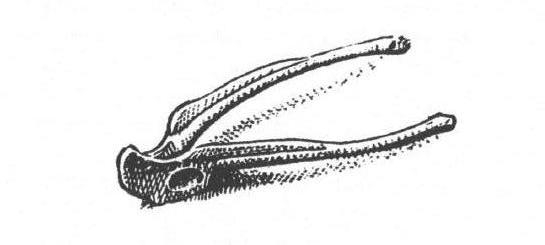Horse Whispering Witch September 16, 2013
Author: Beach Combing | in : Contemporary, Modern , trackbackA weird witchcraft story published in 1984, recalling an event in 1908. The date, the subject matter and the place, East Anglia, are all quite surprising as are the horses. Don’t really know what to make of this one, though it is fun to read.
In 1908 I was a blacksmith’s helper working for Mr Calver of Bourne (Cambs) who had a blacksmith called George Kirk, who is now dead. A local farmer disputed with Calver about this bill, declaring that he had paid Calver’s workmen cash. The men denied this and bore the farmer a grudge on account of this imputation on their honesty. One morning about nine am the farmer was seen approaching in his pony cart. Kirk turned towards the road saying ‘I’ll teach him a lesson’, took out his handkerchief and put it to his nose and then back in his pocket. The pony stopped and refused to go on in spite of his master’s efforts to make him continue. Kirk said to the farmer ‘He’ll stay there all day until I let him go, and if you hit him I’ll hit you.’ The pony stayed there until about 5 pm, when Kirk went over and patted its neck and it moved forward immediately.
As to the origin of the power there is no doubt.
I asked Kirk how he did this and he said ‘Take a frog and put it in an anthill and leave it there for the ants to eat. When nothing but the bones are left, take them and throw them into a stream and carefully watch for one bone which floats upstream. Keep this bone, and you can then give yourself to the devil and have the power I have got.’ I said that I would do this, but Kirk answered ‘Take my advice and don’t: you will never rest if you do.’
Kirk had a way with horses.
There was never an trouble in shoeing horses while Kirk was there. If a young or shy horse was brought in he would first go and pat it and speak to it, and then leave it to the others with the assurance that it would be quite quiet, and it always was. Even horses being shoed for the first time were no trouble.
The author who quotes this account, Tebbutt, refers to the Horseman’s Guild: ‘members of this guild or cult had the power to control horses and claimed that it came from the devil.’ Anything else on the guild?! Drbeachcombing AT yahoo dot com Or had Tebbutt been drinking a bit too much marsh ale?
19 Sept 2013: The Count writes: Interesting post about horse-whispering! Presumably the story can’t be true, since unless you believe in mutant mind-powers, it’s hard to see how anyone could make a horse stand in the same place for 8 hours. Though since the blacksmith specifically forbade the horse’s owner to whip it, threatening him with a beating if he did, and it’s hard to get a completely stationary horse to start moving without the slightest application of physical encouragement, it’s possible that something like this did happen, the trick being purely psychological. More interesting is the detail about summoning the Devil with a magic frog-bone. This is extraordinarily similar to a superstition common among black Americans at that time, except that you needed a certain bone from a black cat. Unfortunately which bone you needed wasn’t at all clearly defined, but if you had the right one, you could summon Satan to any crossroads at midnight and sell him your soul. Stephen D writes: East Anglia was notable for this. The toad bone floating upstream is described, with several of the horsemen’s activities, in George Ewart Evans, The Horse in the Furrow. George Borrow’s Lavengro also describes methods to make a horse stand still, or to steal a stallion out of a field and make him follow you for ten miles or more. It seems to have been done largely by smell.’ Borky writes: Beach I read that spell in a book decades ago possibly even concerning the same story but the guy writing ’bout it supposedly debunked it by claiming frog bones float anyway. Personally I tend towards thinking the selling your soul to the Devil via frog story was a cover for the actual method which may’ve been even more arcane. The part which rings true to me’s the bit where blacksmith Kirk warns learning the art’s a recipe for eternal restlessness. The tricky thing is this’s a warning which tradition says must be issued by both left hand path followers and right hand path followers if their subtle invitation to join their ranks’s supposedly to be binding. Jesus’s version seems to’ve gone “Foxes have their foxholes and birds their nests but the Son of Man has no place to lay his head” though I suggest his version also has many other levels of meaning. I might add it might be no coincidence Mircea Eliade identified blacksmiths not only as kin to shamans but implied they might have a far greater status as both progenitors of the modern age of technology but also as avatars of creator gods like Ptah and Hephaestus ie Kirk [Church] might’ve been running something akin to a school or a coven.’ Thanks Borky, Count and Stephen D !
20 Sept 2013: Huge thanks to Stephen D who sent in many pages from George Ewart Evans, The Horse in the Furrow. The book is extremely interesting and I could type thousands of words (for the pdfs of some relevant pages look here: the frog’s bone). I’m limiting myself to this short passage (246-248). However, important, note that a limited version of the story above appears in Evans too. What was the original source? He also tells us that in Ely and Peterborough there were a class of horse charmers knowns as toadmen. And the typing begins… ‘A toadman was accounted a kind of witch – male witches were common at home time – and got his name from the ritual in which a toad or a frog was involved. Evidence of some of these practices have been found in the Stowmarket area of Suffolk. But before discussing these it would be well to ask: what was the ritual of the toad or frog’s bone, and what was its purpose? The ritual is a primitive survival that is, or was, practiced in countries as far apart as Scotland and India. As described to the writer by an old horseman living in the Stowmarket area, to obtain the power of the frog’s bone one had to perform the following ritual: ‘You get a frog and take it to a running stream at midnight, but before this you have killed it and pounded it up. You throw it into the water and some of it will flow downstream, but a part of it – a bone – will float upstream. This is the part you have to keep.’ More evidence from a village in the same district has show that the village wart-charmer is belived to have gained his powers in this way. He followed the ritual of the frog’s bone: ‘He took a frog to running water a midnight and he sold his soul to the devil, and now he has the power to cure warts.’… Thomas Davidson has recorded instances of identical practices in the Cottenham district of Cambridgeshire and in parts of Cornwall. Possession of the grog’s bone was believed to give a horseman absolute power over the most intractable horse that came into his care. ‘With the frog’s boon’, said one horseman in this district of Suffolk, ‘you could do anything you like with a horse; take him upstairs if you wanted to.’ But which bone of the frog was the one preferred? The bone can be identified without much doubt both from descriptions given here: ‘It was like a chicken’s wish bone in shape: my father used to keep it in his trouser pocket’ (an old Suffolk horseman is the narrator), and from a passage in abook describing a piece of Indian folklore. In India the frog was wrapped in a piece of white linen and given astrological benedictions. It was then put on an ant hill at sunset. The ants ate the flesh and left the bones, and two bones were then kept. One of these was to hook the object desired – the love in this case; the other to reject him. This latter bone was called the shovel, and is probably the supra-scapula of the frog. The book or wish-bone – the bone kept by the horsemen here – is without much doubt the ilium, the chief bone in the frog’s pelvic girdle. Another horseman from this area of Suffolk has given the pith of the matter in an observation: ‘The frog’s boon was the same shape as the frog in a horse’s hoof; and if there was any doubt about the identity of the particular bone used by the old horsemen, this similarity would appear to dispel it.’ Thanks Stephen!
1 Oct 2013: Puny Chick with Attitude writes in: Dead-frog to ant-hill to floating-in-the-river is something I’ve heard about as “bone magic.” Specifically used in gentling horses. In her historical novel, Mistress of the Sun (2009), Sandra Gulland describes the ritual at length. A young girl uses it to tame a very wild horse that is to be otherwise destroyed. As the story progresses, it is implied that our heroine has made a pact w/darkness. Here’s the Amazon link: Thanks Puny!




